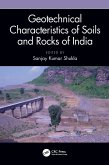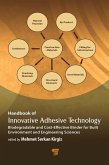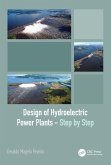Didier Néraudeau, Jean-David Moreau
Fossilization (eBook, ePUB)
Fundamental Principles and Cases of Exceptional Fossilizations
142,99 €
142,99 €
inkl. MwSt.
Sofort per Download lieferbar

0 °P sammeln
142,99 €
Als Download kaufen

142,99 €
inkl. MwSt.
Sofort per Download lieferbar

0 °P sammeln
Jetzt verschenken
Alle Infos zum eBook verschenken
142,99 €
inkl. MwSt.
Sofort per Download lieferbar
Alle Infos zum eBook verschenken

0 °P sammeln
Didier Néraudeau, Jean-David Moreau
Fossilization (eBook, ePUB)
Fundamental Principles and Cases of Exceptional Fossilizations
- Format: ePub
- Merkliste
- Auf die Merkliste
- Bewerten Bewerten
- Teilen
- Produkt teilen
- Produkterinnerung
- Produkterinnerung

Bitte loggen Sie sich zunächst in Ihr Kundenkonto ein oder registrieren Sie sich bei
bücher.de, um das eBook-Abo tolino select nutzen zu können.
Hier können Sie sich einloggen
Hier können Sie sich einloggen
Sie sind bereits eingeloggt. Klicken Sie auf 2. tolino select Abo, um fortzufahren.

Bitte loggen Sie sich zunächst in Ihr Kundenkonto ein oder registrieren Sie sich bei bücher.de, um das eBook-Abo tolino select nutzen zu können.
There are many books devoted to palaeontology and fossils. However, none have yet dealt with the processes of fossilization, from the formation of the most common fossils to the more exceptional mineralization of animal remains, plants, micro-organisms and even molecules.
Fossilization offers an exhaustive review of fossilization, combining an explanation of the processes involved, reference to the deposits that deliver the different types of fossils, and illustrations of representative specimens. As the exceptional fossiliferous sites of the French territory fully reflect the multitude of…mehr
- Geräte: eReader
- mit Kopierschutz
- eBook Hilfe
- Größe: 32.95MB
Andere Kunden interessierten sich auch für
![Fossilization (eBook, PDF) Fossilization (eBook, PDF)]() Didier NéraudeauFossilization (eBook, PDF)142,99 €
Didier NéraudeauFossilization (eBook, PDF)142,99 €![Geotechnical Characteristics of Soils and Rocks of India (eBook, ePUB) Geotechnical Characteristics of Soils and Rocks of India (eBook, ePUB)]() Geotechnical Characteristics of Soils and Rocks of India (eBook, ePUB)69,95 €
Geotechnical Characteristics of Soils and Rocks of India (eBook, ePUB)69,95 €![Design Methodology in Rock Engineering (eBook, ePUB) Design Methodology in Rock Engineering (eBook, ePUB)]() Z. T. BieniawskiDesign Methodology in Rock Engineering (eBook, ePUB)118,95 €
Z. T. BieniawskiDesign Methodology in Rock Engineering (eBook, ePUB)118,95 €![Handbook of Innovative Adhesive Technology (eBook, ePUB) Handbook of Innovative Adhesive Technology (eBook, ePUB)]() Handbook of Innovative Adhesive Technology (eBook, ePUB)189,95 €
Handbook of Innovative Adhesive Technology (eBook, ePUB)189,95 €![Unsaturated Soil Mechanics with Probability and Statistics (eBook, ePUB) Unsaturated Soil Mechanics with Probability and Statistics (eBook, ePUB)]() Ryosuke KitamuraUnsaturated Soil Mechanics with Probability and Statistics (eBook, ePUB)47,95 €
Ryosuke KitamuraUnsaturated Soil Mechanics with Probability and Statistics (eBook, ePUB)47,95 €![Design of Hydroelectric Power Plants - Step by Step (eBook, ePUB) Design of Hydroelectric Power Plants - Step by Step (eBook, ePUB)]() Geraldo Magela PereiraDesign of Hydroelectric Power Plants - Step by Step (eBook, ePUB)157,95 €
Geraldo Magela PereiraDesign of Hydroelectric Power Plants - Step by Step (eBook, ePUB)157,95 €![Practical Engineering Geology (eBook, ePUB) Practical Engineering Geology (eBook, ePUB)]() Steve HencherPractical Engineering Geology (eBook, ePUB)81,95 €
Steve HencherPractical Engineering Geology (eBook, ePUB)81,95 €-
-
-
There are many books devoted to palaeontology and fossils. However, none have yet dealt with the processes of fossilization, from the formation of the most common fossils to the more exceptional mineralization of animal remains, plants, micro-organisms and even molecules.
Fossilization offers an exhaustive review of fossilization, combining an explanation of the processes involved, reference to the deposits that deliver the different types of fossils, and illustrations of representative specimens. As the exceptional fossiliferous sites of the French territory fully reflect the multitude of cases of fossilization - from the most common to the most original ¬- they are showcased here.
Fossilization offers an exhaustive review of fossilization, combining an explanation of the processes involved, reference to the deposits that deliver the different types of fossils, and illustrations of representative specimens. As the exceptional fossiliferous sites of the French territory fully reflect the multitude of cases of fossilization - from the most common to the most original ¬- they are showcased here.
Dieser Download kann aus rechtlichen Gründen nur mit Rechnungsadresse in D ausgeliefert werden.
Produktdetails
- Produktdetails
- Verlag: John Wiley & Sons
- Seitenzahl: 306
- Erscheinungstermin: 26. August 2025
- Englisch
- ISBN-13: 9781394406258
- Artikelnr.: 75314326
- Verlag: John Wiley & Sons
- Seitenzahl: 306
- Erscheinungstermin: 26. August 2025
- Englisch
- ISBN-13: 9781394406258
- Artikelnr.: 75314326
- Herstellerkennzeichnung Die Herstellerinformationen sind derzeit nicht verfügbar.
Didier Néraudeau is Professor of Paleontology at the University of Rennes, France. His research focuses on all types of fossils, from all geological eras.
Jean-David Moreau is a paleontologist at the University of Paris-Saclay, France. His research focuses on the reconstruction of Paleozoic and Mesozoic continental paleoecosystems, combining paleobotany, paleoichnology and sedimentology.
Jean-David Moreau is a paleontologist at the University of Paris-Saclay, France. His research focuses on the reconstruction of Paleozoic and Mesozoic continental paleoecosystems, combining paleobotany, paleoichnology and sedimentology.
Foreword ix
Bruno DAVID
Acknowledgments xiii
Chapter 1 General Points 1
1.1 Fossilization: a phenomenon that is always exceptional 1
1.2 The main processes of fossilization 3
1.2.1 Preservation of the endo- or exoskeletal elements 7
1.2.2 Formation of replicas or countermolds 8
1.2.3 Formation of internal molds 9
1.2.4 Case study: geode formation 10
1.3 The concept of a Lagerstätten 13
Chapter 2 Diversity of Types of Mineralization 17
2.1 Silicification 17
2.1.1 Primary silicification 18
2.1.2 Secondary silicification 28
2.2 Carbonization of plants and compressions of cuticles 43
2.2.1 Carbonification due to anoxia 44
2.2.2 Carbonization in connection with forest fires 44
2.2.3 Biogeochemical carbonization (also known as "diagenetic
carbonization") 46
2.2.4 Plant compressions 49
2.2.5 Imprints and casts 53
2.3 Carbonatizations and calcitic crystallizations 55
2.3.1 Carbonatization by encrusting and impregnation 55
2.3.2 Carbonatization by percolation and recrystallization 58
2.3.3 Geodes and calcitic outgrowths 61
2.3.4 Crystalline fossils formed of carbonates 65
2.4 Pyritization, limonitization and siderite 67
2.4.1 Pyritization 67
2.4.2 Fossils made of iron oxides or hydroxides 80
2.4.3 Siderite nodules 82
2.5 Amberization 84
2.5.1 Copal 85
2.5.2 Amber 86
2.6 Sulfatization (gypsification and mineralization as barite) 92
2.6.1 Gypsification 93
2.6.2 Mineralization to barite 94
2.7 Phosphatization 95
2.7.1 Phosphateous nodules 95
2.7.2 Phosphorites 96
2.7.3 Crystalline phosphate fossils 97
2.8 Bituminous facies 99
Chapter 3 Remarkable Cases and Fossiliferous Contexts 105
3.1 Burial in fine, layered mud 106
3.1.1 The role of microbial mats in Precambrian and Cambrian shales 106
3.1.2 The role of microbial or algal mats in pelites and lithographic
limestones 108
3.1.3 Anoxia of laminar clays bearing plants 112
3.1.4 Diatomites 115
3.2 Accumulations of teeth 118
3.3 Bone beds 121
3.4 Fossilized tracks and trackways 123
3.5 Fossils with anatomical connections 128
3.6 Eggs and trophic traces (bite marks, galls, regurgitations and
coprolites) 132
3.7 Land-based palynomorphs: spores and pollen grains 140
3.8 Aquatic palynomorphs 145
3.9 Aquatic microfossils: algae, foraminifera and ostracods 148
Chapter 4 Molecular Preservation 159
4.1 Color fossilization 159
4.1.1 Fossils with preserved colors 160
4.1.2 Fossils where the colors are absent, but can be revealed 165
4.2 Fossilization of the original chemical compositions 166
4.3 Fossilized DNA 167
Conclusion 173
References 175
List of Figures 201
List of Plates 203
List of Authors 209
Index 211
Bruno DAVID
Acknowledgments xiii
Chapter 1 General Points 1
1.1 Fossilization: a phenomenon that is always exceptional 1
1.2 The main processes of fossilization 3
1.2.1 Preservation of the endo- or exoskeletal elements 7
1.2.2 Formation of replicas or countermolds 8
1.2.3 Formation of internal molds 9
1.2.4 Case study: geode formation 10
1.3 The concept of a Lagerstätten 13
Chapter 2 Diversity of Types of Mineralization 17
2.1 Silicification 17
2.1.1 Primary silicification 18
2.1.2 Secondary silicification 28
2.2 Carbonization of plants and compressions of cuticles 43
2.2.1 Carbonification due to anoxia 44
2.2.2 Carbonization in connection with forest fires 44
2.2.3 Biogeochemical carbonization (also known as "diagenetic
carbonization") 46
2.2.4 Plant compressions 49
2.2.5 Imprints and casts 53
2.3 Carbonatizations and calcitic crystallizations 55
2.3.1 Carbonatization by encrusting and impregnation 55
2.3.2 Carbonatization by percolation and recrystallization 58
2.3.3 Geodes and calcitic outgrowths 61
2.3.4 Crystalline fossils formed of carbonates 65
2.4 Pyritization, limonitization and siderite 67
2.4.1 Pyritization 67
2.4.2 Fossils made of iron oxides or hydroxides 80
2.4.3 Siderite nodules 82
2.5 Amberization 84
2.5.1 Copal 85
2.5.2 Amber 86
2.6 Sulfatization (gypsification and mineralization as barite) 92
2.6.1 Gypsification 93
2.6.2 Mineralization to barite 94
2.7 Phosphatization 95
2.7.1 Phosphateous nodules 95
2.7.2 Phosphorites 96
2.7.3 Crystalline phosphate fossils 97
2.8 Bituminous facies 99
Chapter 3 Remarkable Cases and Fossiliferous Contexts 105
3.1 Burial in fine, layered mud 106
3.1.1 The role of microbial mats in Precambrian and Cambrian shales 106
3.1.2 The role of microbial or algal mats in pelites and lithographic
limestones 108
3.1.3 Anoxia of laminar clays bearing plants 112
3.1.4 Diatomites 115
3.2 Accumulations of teeth 118
3.3 Bone beds 121
3.4 Fossilized tracks and trackways 123
3.5 Fossils with anatomical connections 128
3.6 Eggs and trophic traces (bite marks, galls, regurgitations and
coprolites) 132
3.7 Land-based palynomorphs: spores and pollen grains 140
3.8 Aquatic palynomorphs 145
3.9 Aquatic microfossils: algae, foraminifera and ostracods 148
Chapter 4 Molecular Preservation 159
4.1 Color fossilization 159
4.1.1 Fossils with preserved colors 160
4.1.2 Fossils where the colors are absent, but can be revealed 165
4.2 Fossilization of the original chemical compositions 166
4.3 Fossilized DNA 167
Conclusion 173
References 175
List of Figures 201
List of Plates 203
List of Authors 209
Index 211
Foreword ix
Bruno DAVID
Acknowledgments xiii
Chapter 1 General Points 1
1.1 Fossilization: a phenomenon that is always exceptional 1
1.2 The main processes of fossilization 3
1.2.1 Preservation of the endo- or exoskeletal elements 7
1.2.2 Formation of replicas or countermolds 8
1.2.3 Formation of internal molds 9
1.2.4 Case study: geode formation 10
1.3 The concept of a Lagerstätten 13
Chapter 2 Diversity of Types of Mineralization 17
2.1 Silicification 17
2.1.1 Primary silicification 18
2.1.2 Secondary silicification 28
2.2 Carbonization of plants and compressions of cuticles 43
2.2.1 Carbonification due to anoxia 44
2.2.2 Carbonization in connection with forest fires 44
2.2.3 Biogeochemical carbonization (also known as "diagenetic
carbonization") 46
2.2.4 Plant compressions 49
2.2.5 Imprints and casts 53
2.3 Carbonatizations and calcitic crystallizations 55
2.3.1 Carbonatization by encrusting and impregnation 55
2.3.2 Carbonatization by percolation and recrystallization 58
2.3.3 Geodes and calcitic outgrowths 61
2.3.4 Crystalline fossils formed of carbonates 65
2.4 Pyritization, limonitization and siderite 67
2.4.1 Pyritization 67
2.4.2 Fossils made of iron oxides or hydroxides 80
2.4.3 Siderite nodules 82
2.5 Amberization 84
2.5.1 Copal 85
2.5.2 Amber 86
2.6 Sulfatization (gypsification and mineralization as barite) 92
2.6.1 Gypsification 93
2.6.2 Mineralization to barite 94
2.7 Phosphatization 95
2.7.1 Phosphateous nodules 95
2.7.2 Phosphorites 96
2.7.3 Crystalline phosphate fossils 97
2.8 Bituminous facies 99
Chapter 3 Remarkable Cases and Fossiliferous Contexts 105
3.1 Burial in fine, layered mud 106
3.1.1 The role of microbial mats in Precambrian and Cambrian shales 106
3.1.2 The role of microbial or algal mats in pelites and lithographic
limestones 108
3.1.3 Anoxia of laminar clays bearing plants 112
3.1.4 Diatomites 115
3.2 Accumulations of teeth 118
3.3 Bone beds 121
3.4 Fossilized tracks and trackways 123
3.5 Fossils with anatomical connections 128
3.6 Eggs and trophic traces (bite marks, galls, regurgitations and
coprolites) 132
3.7 Land-based palynomorphs: spores and pollen grains 140
3.8 Aquatic palynomorphs 145
3.9 Aquatic microfossils: algae, foraminifera and ostracods 148
Chapter 4 Molecular Preservation 159
4.1 Color fossilization 159
4.1.1 Fossils with preserved colors 160
4.1.2 Fossils where the colors are absent, but can be revealed 165
4.2 Fossilization of the original chemical compositions 166
4.3 Fossilized DNA 167
Conclusion 173
References 175
List of Figures 201
List of Plates 203
List of Authors 209
Index 211
Bruno DAVID
Acknowledgments xiii
Chapter 1 General Points 1
1.1 Fossilization: a phenomenon that is always exceptional 1
1.2 The main processes of fossilization 3
1.2.1 Preservation of the endo- or exoskeletal elements 7
1.2.2 Formation of replicas or countermolds 8
1.2.3 Formation of internal molds 9
1.2.4 Case study: geode formation 10
1.3 The concept of a Lagerstätten 13
Chapter 2 Diversity of Types of Mineralization 17
2.1 Silicification 17
2.1.1 Primary silicification 18
2.1.2 Secondary silicification 28
2.2 Carbonization of plants and compressions of cuticles 43
2.2.1 Carbonification due to anoxia 44
2.2.2 Carbonization in connection with forest fires 44
2.2.3 Biogeochemical carbonization (also known as "diagenetic
carbonization") 46
2.2.4 Plant compressions 49
2.2.5 Imprints and casts 53
2.3 Carbonatizations and calcitic crystallizations 55
2.3.1 Carbonatization by encrusting and impregnation 55
2.3.2 Carbonatization by percolation and recrystallization 58
2.3.3 Geodes and calcitic outgrowths 61
2.3.4 Crystalline fossils formed of carbonates 65
2.4 Pyritization, limonitization and siderite 67
2.4.1 Pyritization 67
2.4.2 Fossils made of iron oxides or hydroxides 80
2.4.3 Siderite nodules 82
2.5 Amberization 84
2.5.1 Copal 85
2.5.2 Amber 86
2.6 Sulfatization (gypsification and mineralization as barite) 92
2.6.1 Gypsification 93
2.6.2 Mineralization to barite 94
2.7 Phosphatization 95
2.7.1 Phosphateous nodules 95
2.7.2 Phosphorites 96
2.7.3 Crystalline phosphate fossils 97
2.8 Bituminous facies 99
Chapter 3 Remarkable Cases and Fossiliferous Contexts 105
3.1 Burial in fine, layered mud 106
3.1.1 The role of microbial mats in Precambrian and Cambrian shales 106
3.1.2 The role of microbial or algal mats in pelites and lithographic
limestones 108
3.1.3 Anoxia of laminar clays bearing plants 112
3.1.4 Diatomites 115
3.2 Accumulations of teeth 118
3.3 Bone beds 121
3.4 Fossilized tracks and trackways 123
3.5 Fossils with anatomical connections 128
3.6 Eggs and trophic traces (bite marks, galls, regurgitations and
coprolites) 132
3.7 Land-based palynomorphs: spores and pollen grains 140
3.8 Aquatic palynomorphs 145
3.9 Aquatic microfossils: algae, foraminifera and ostracods 148
Chapter 4 Molecular Preservation 159
4.1 Color fossilization 159
4.1.1 Fossils with preserved colors 160
4.1.2 Fossils where the colors are absent, but can be revealed 165
4.2 Fossilization of the original chemical compositions 166
4.3 Fossilized DNA 167
Conclusion 173
References 175
List of Figures 201
List of Plates 203
List of Authors 209
Index 211







